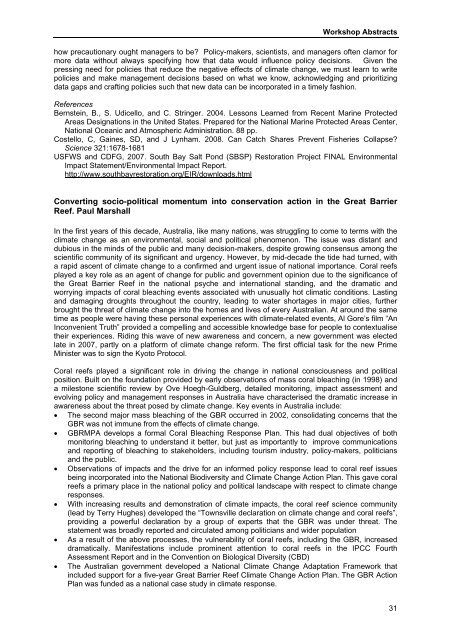Obura2009-IUCN Congress report - Resilience sessions
Obura2009-IUCN Congress report - Resilience sessions.pdf
Obura2009-IUCN Congress report - Resilience sessions.pdf
You also want an ePaper? Increase the reach of your titles
YUMPU automatically turns print PDFs into web optimized ePapers that Google loves.
Workshop Abstracts<br />
how precautionary ought managers to be? Policy-makers, scientists, and managers often clamor for<br />
more data without always specifying how that data would influence policy decisions. Given the<br />
pressing need for policies that reduce the negative effects of climate change, we must learn to write<br />
policies and make management decisions based on what we know, acknowledging and prioritizing<br />
data gaps and crafting policies such that new data can be incorporated in a timely fashion.<br />
References<br />
Bernstein, B., S. Udicello, and C. Stringer. 2004. Lessons Learned from Recent Marine Protected<br />
Areas Designations in the United States. Prepared for the National Marine Protected Areas Center,<br />
National Oceanic and Atmospheric Administration. 88 pp.<br />
Costello, C, Gaines, SD, and J Lynham. 2008. Can Catch Shares Prevent Fisheries Collapse?<br />
Science 321:1678-1681<br />
USFWS and CDFG, 2007. South Bay Salt Pond (SBSP) Restoration Project FINAL Environmental<br />
Impact Statement/Environmental Impact Report.<br />
http://www.southbayrestoration.org/EIR/downloads.html<br />
Converting socio-political momentum into conservation action in the Great Barrier<br />
Reef. Paul Marshall<br />
In the first years of this decade, Australia, like many nations, was struggling to come to terms with the<br />
climate change as an environmental, social and political phenomenon. The issue was distant and<br />
dubious in the minds of the public and many decision-makers, despite growing consensus among the<br />
scientific community of its significant and urgency. However, by mid-decade the tide had turned, with<br />
a rapid ascent of climate change to a confirmed and urgent issue of national importance. Coral reefs<br />
played a key role as an agent of change for public and government opinion due to the significance of<br />
the Great Barrier Reef in the national psyche and international standing, and the dramatic and<br />
worrying impacts of coral bleaching events associated with unusually hot climatic conditions. Lasting<br />
and damaging droughts throughout the country, leading to water shortages in major cities, further<br />
brought the threat of climate change into the homes and lives of every Australian. At around the same<br />
time as people were having these personal experiences with climate-related events, Al Gore’s film “An<br />
Inconvenient Truth” provided a compelling and accessible knowledge base for people to contextualise<br />
their experiences. Riding this wave of new awareness and concern, a new government was elected<br />
late in 2007, partly on a platform of climate change reform. The first official task for the new Prime<br />
Minister was to sign the Kyoto Protocol.<br />
Coral reefs played a significant role in driving the change in national consciousness and political<br />
position. Built on the foundation provided by early observations of mass coral bleaching (in 1998) and<br />
a milestone scientific review by Ove Hoegh-Guldberg, detailed monitoring, impact assessment and<br />
evolving policy and management responses in Australia have characterised the dramatic increase in<br />
awareness about the threat posed by climate change. Key events in Australia include:<br />
• The second major mass bleaching of the GBR occurred in 2002, consolidating concerns that the<br />
GBR was not immune from the effects of climate change.<br />
• GBRMPA develops a formal Coral Bleaching Response Plan. This had dual objectives of both<br />
monitoring bleaching to understand it better, but just as importantly to improve communications<br />
and <strong>report</strong>ing of bleaching to stakeholders, including tourism industry, policy-makers, politicians<br />
and the public.<br />
• Observations of impacts and the drive for an informed policy response lead to coral reef issues<br />
being incorporated into the National Biodiversity and Climate Change Action Plan. This gave coral<br />
reefs a primary place in the national policy and political landscape with respect to climate change<br />
responses.<br />
• With increasing results and demonstration of climate impacts, the coral reef science community<br />
(lead by Terry Hughes) developed the “Townsville declaration on climate change and coral reefs”,<br />
providing a powerful declaration by a group of experts that the GBR was under threat. The<br />
statement was broadly <strong>report</strong>ed and circulated among politicians and wider population<br />
• As a result of the above processes, the vulnerability of coral reefs, including the GBR, increased<br />
dramatically. Manifestations include prominent attention to coral reefs in the IPCC Fourth<br />
Assessment Report and in the Convention on Biological Diversity (CBD)<br />
• The Australian government developed a National Climate Change Adaptation Framework that<br />
included support for a five-year Great Barrier Reef Climate Change Action Plan. The GBR Action<br />
Plan was funded as a national case study in climate response.<br />
31


















